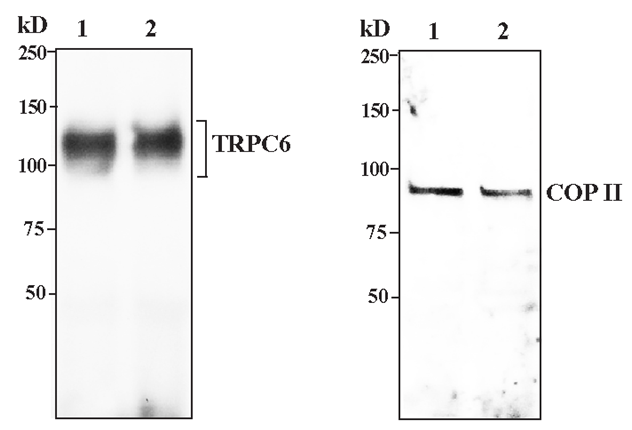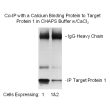CHAPS IMMUNOPRECIPITATION (IP) AND LYSIS BUFFER For Tissues and Cells | Part No. CIB-1
 Click to enlarge |
|
|
Cell Lysis Buffer with CHAPS Detergent: Immunoprecipitation (IP) and Cell Lysis Buffer with CHAPS Detergent (IP Lysis Buffer)
Updated 8-2023
Protein extraction and immunoprecipitation for tissue and cell culture samples
CHAPS immunoprecipitation and lysis buffer with 0.5% CHAPS, HEPES, NaCl, 1X Solution. Preserves native protein conformation
Available Volumes
Available Formulations
*All pH's are offered at the same price.
The addition of calcium chloride to the CHAPS reagent preserves calcium dependent protein-protein interaction, whereas the addition of EDTA abrogates the interaction.
Highlights: CHAPS Buffer
IP and Lysis Protocol
Representative data with CHAPS Immunoprecipitation and Cell Lysis Reagent (pH 8.0)
Figure 1
Co-immunoprecipitation (Co-IP) of a trafficking protein receptor (COPII) with a cation channel (TRPC-6). HEK293 cells were co-transfected with plasmid DNA encoding TPRC-6 and a HA epitope tagged component of COPII (sec24). Cell lysis and immunoprecipitation were performed in CHAPS Buffer as summarized in the product manual. Western blotting (WB) was performed with the antibodies indicated in the figure.

IP: Anti-HA COPII IP: Anti-HA COPII
WB: Anti-TRPC6 WB: COPII
Figure 2
Co-immunoprecipitation (Co-IP) of a calcium binding protein with a multisubunit target protein 1 employing the FIVEphoton CHAPS immunoprecipitation reagent. A larger amount of target protein 1 associates with the calcium binding protein when expressed alone, as compared to co-expression (and presumed assembly) with protein 2. Protein 1 reveals higher molecular weight forms due to post-translational modifications.

Outline of immunoprecipitation methodology with CHAPS Buffer (see details in protocol)

©Fivephoton Biochemicals 2010
Product Citations
1. Thakur, A., Park, K., Cullum, R. et al. (2024) HNF4A guides the MLL4 complex to establish and maintain H3K4me1 at gene regulatory elements. Commun Biol 7, 144. Link to article 2. Takata, Katsuyoshi, et al. (2022) "Tumor-associated antigen PRAME exhibits dualistic functions that are targetable in diffuse large B cell lymphoma." The Journal of Clinical Investigation 132.10 (2022). Link to article
3. Christopher R. Donnelly, et al. (2021). STING controls nociception via type I interferon signalling in sensory neurons. Nature volume 591, 275–280. Link to article
4. Joe Truong Nguyen, (2018). Mammalian EAK-7 activates alternative mTOR signaling to regulate cell proliferation and migration. Science Advances 09 May 2018: Vol. 4, no. 5, eaao5838. Link to article
5. Drum, Benjamin ML, et al. "Oxidative stress decreases microtubule growth and stability in ventricular myocytes." Journal of molecular and cellular cardiology 93 (2016): 32-43. Link to article
6. Villa‐Diaz, Luis G., et al. "Inhibition of Focal Adhesion Kinase Signaling by Integrin α6β1 Supports Human Pluripotent Stem Cell Self‐Renewal." Stem Cells (2016). Link to article
7. Kurland, D. B., Gerzanich, V., Karimy, J. K., Woo, S. K., Vennekens, R., Freichel, M., ... & Simard, J. M. (2016). The Sur1-Trpm4 channel regulates NOS2 transcription in TLR4-activated microglia. Journal of Neuroinflammation, 13(1). Link to article
8. Qian, X., Kim, J.K., Tong, W., Villa‐Diaz, L.G. and Krebsbach, P.H., 2015. DPPA5 Supports Pluripotency and Reprogramming by Regulating NANOG Turnover. STEM CELLS. Link to article
9. Zhang G, Brady J, Liang W-C, Wu Y, Henkemeyer M, Yan M. EphB4 forward signalling regulates lymphatic valve development. Nature Communications. 2015;6:6625. doi:10.1038/ncomms7625. Link to articleCell Surface Protein Disulfide Isomerase Regulates Natriuretic Peptide Generation of Cyclic Guanosine Monophosphate. Plos One. DOI: 10.1371/journal.pone.0112986. Link to article
IP and Lysis Protocol
Ordering
In addition to direct orders, this item can be purchased on fishersci.com and shipped to the customer from Fivephoton Biochemicals: fishersci.com item no. NC0221482, NC0982453. CHAPS buffer (CIB-1) is also available from distributors of Fivephoton Biochemicals.
Safety: Irritant. Avoid skin and eye contact and ingestion.
Storage: 4oC.
Shipping: Ships at ambient temperature. International delivery is available.
kw:
IP Lysis Buffer, CHAPS Buffer, Immunoprecipitation, Protein extraction, Cell lysis, Protein, IP, Calcium binding protein, Co-IP, Pull down assay
|
 Products
Products Manuals
Manuals




 - FIVEphoton Biochemicals-80x80.jpg)


